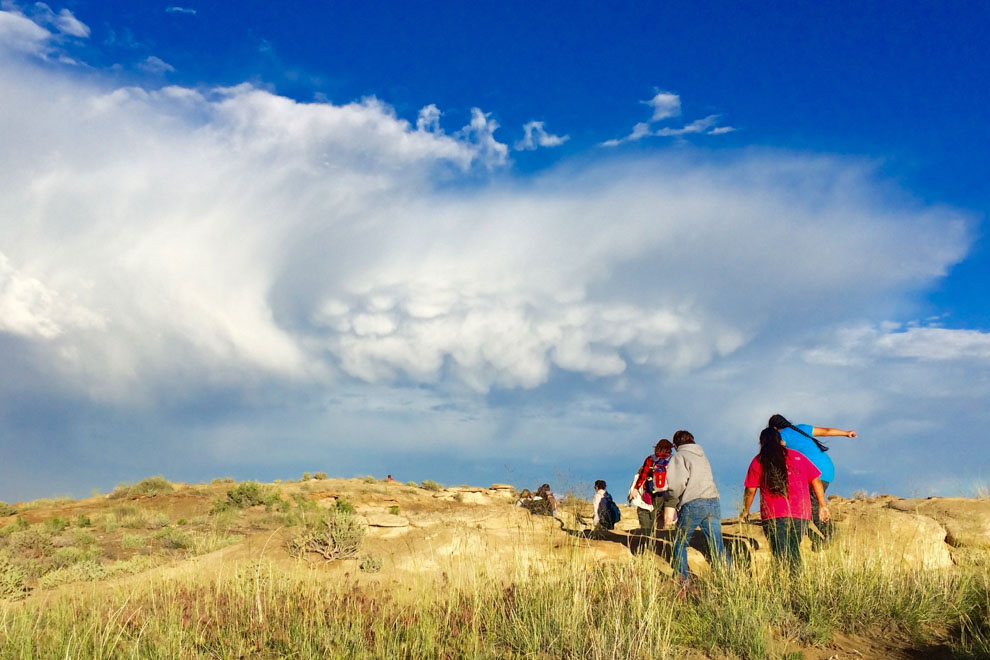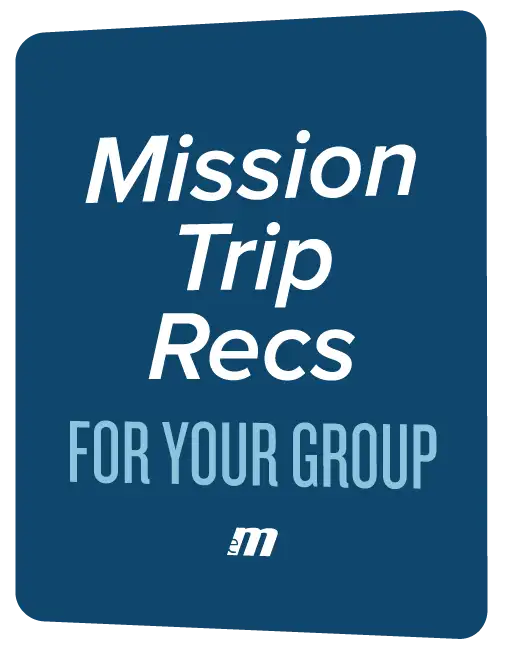
Illinois
Texas
North Carolina/Tennessee
North Carolina
Michigan
Arizona
New Mexico
New York
Kentucky
Maine
Texas
Georgia
Belize
Cuba
Jamaica
Puerto Rico (U.S.)
Costa Rica
South Africa
South Africa
Namibia
Indonesia













6th Grade & Up
Summer
$535/person (6-Day Trip)
Community Overview
- Discover Navajo culture: Explore the cultural richness and beauty of the Navajo Nation in New Mexico.
- Serve alongside locals: Work with Navajo pastors and community members on various work projects.
- Experience cross-cultural ministry: Learn from Native Americans and build relationships in a unique setting.
Work alongside Diné (Navajo) people serving their community through home and church repair projects, church outreach programs, or kids' ministry. Discover churches striving to honor God and sacrificially serve their communities with hearts of love and generosity.
Connect directly with EM Support Staff to learn more about 2026 Native American mission trips in New Mexico — submit an interest form today!
Meet our Local Partners
Local Partners
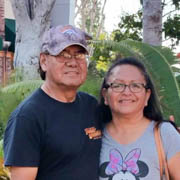
Details & Logistics
Activities & Opportunities
You will be sleeping at a local church on the Navajo Reservation in a remote desert region of New Mexico, and you will be working in the surrounding area. Because the Navajo people are spread out over a large space, you should expect to drive as much as 30-45 minutes to your worksites. We think you'll enjoy the beautiful desert scenery that surrounds you whether driving, working, or simply enjoying time at church.
By serving on the Navajo Reservation, you can genuinely impact the lives of others. You have the unique opportunity to live and work among the Navajo. You will partner with the local churches and practically serve the people around you by meeting real needs in tangible ways. If you come with a genuine heart to connect with people, you will build meaningful relationships and encourage those around you as you become a picture of God's love.
Work Projects
Your team will participate in practical work projects in support of the local church that is hosting your team. This primarily consists of construction-related projects such as tiling, dry-walling, roofing, framing, cement work, painting, and various kinds of repairs/remodeling. Depending on the needs of a given week, your team's projects will focus on helping local families or working on projects that serve the local church. Specific construction skills are very helpful but not required. We simply ask that you come with a willing heart that is prepared to work to the best of your ability.
Outreach Ministry
Due to the unique nature of this community, the opportunity for relational ministry may take place directly at your team's worksite as you come alongside and encourage those you have come to serve. There may be additional opportunities to serve in various types of people ministry if the need arises. These types of ministry could include things like visiting the elderly, gardening, cleaning, etc.
*NOTE: Experience Mission works closely with local leaders to identify work projects and ministry opportunities that address authentic needs within the community. We ask that you come with a servant's heart and willingness to adapt to the unique qualities represented in each location. Opportunities can vary significantly from one week to the next. Your team may work at one location or serve at multiple locations each day. Due to the changing needs of our community partners, we cannot confirm your specific activities until your team arrives.
Children's Ministry
Depending upon the needs of this community Kids Club may or may not be offered. * When offered, Kids Club is a popular activity with teams. To best serve the needs of the local kids and to maintain consistency, we feel it is optimal for 1 team to lead the entire week of Kids Club. It is offered on a first-come, first-served basis to teams in the order of their registration for the trip. Leading Kids Club is an important outreach ministry. We ask teams who request participation in this ministry, to embrace that responsibility and come well-prepared for their role in leading Kids Club. If your team has a strong desire to work with children please contact us early on to see if this ministry opportunity is still available. Your team must be registered for the trip to be assigned Kids Club.
Kids Club normally lasts between 90 minutes and 2.5 hours and will take place either during the late morning or early afternoon depending on the needs of the community. We typically have between 6-15 children attend and need a maximum of 3-5 people to lead Kids Club each day. If your team chooses to participate in Kids Club, Experience Mission will provide the curriculum for your team's use. This Kids Club curriculum will be sent out to Team Leaders in the spring via email.
Teams will be responsible for bringing the craft supplies needed for their specific crafts and should budget appropriately. While we do our best to make sure the craft materials are cost effective, teams may feel free to augment any materials to make them more suitable for their budget. Experience Mission will supply scissors, staplers, and paper hole punches. There are plenty of opportunities to connect with local children through games like soccer or Frisbee. Tuck in a hackysack, football, or jump rope as they are sure to come in handy.
*Due to varying school schedules, Kids Club is not offered on mission trips from September-May.
Spring Break Trips
Due to staffing limitations and varying school schedules in our community locations, Kids Club and Evening Gathering are not offered during spring break trips. Teams should plan to prepare their own worship & devotional materials for trips from February-May.
Community Profile
The Navajo people (also known as Diné) occupy the largest Native American reservation in the United States. The land area is approximately the size of West Virginia, and nearly 300,000 Navajo are living throughout the United States and of these 58% live within the boundaries of the reservation. The Navajo retain a unique identity and language and comprise one of the most distinct subcultures within the United States.
The Navajo Nation has its own government that exists as an entity under the US government. The Reservation is divided into 110 chapters of which each has a governing council. Consisting of an executive, legislative, and judicial branch, the seat of Navajo government is in Window Rock, and there the Navajo council convenes with 88 members representing the 110 chapters. The Nation has its own laws, and there is a tribal police department. The Navajo government owns the entirety of Reservation lands, and residents lease the parcels for various uses such as home site lease and church site lease.
Natural Environment
The Navajo Reservation is set in the desert of Northeastern Arizona and Northwestern New Mexico and stretches into the southern section of Utah. The area is classified as high desert and typically ranges from around 5000-7000 feet in elevation. This makes for a harsh climate plagued with scorching heat in the summer and cold temperatures with snow and ice in the winter. It is very dry and in most places wide open, so severe dust storms can develop. Most of the land consists of desert plains, but there are sections of canyons, hills, and mountains. There are many natural and historic attractions such as canyons and ancient ruins throughout the reservation. These ruins can be found in such places as Navajo Monument, Chaco Canyon, and Canyon de Chelly. Other tourist attractions include Four Corners Monument, the Bistà Badlands, and Monument Valley.
Lifestyle
The Navajo dwell in isolated houses or small compounds all over the Reservation. Many families continue to herd sheep and farm, but it is also common for Navajo to work skilled trades or commute into the cities. Modern amenities have not reached every area, and there are still high percentages of Navajo living without electricity or running water. While most Navajo live in contemporary homes, there are still some who live in traditional hogans, and in Canyon de Chelly there are households living much as they have for hundreds of years. A growing number of people have mobile phones and internet connections, but cell service can be spotty and landlines are rare.
Needs
Because a lack of economic development, unemployment among the Navajo is very high. Further, alcoholism and drugs are severe issues. Many of the older people do not speak English, and their children are often unemployed or have moved away, so there is a great need to care for the elderly. For some, it is a struggle to keep adequate food and nutrition, and proper home maintenance is at times unattainable. Often Navajo live in trailers that were poorly constructed and have been used far beyond their adequate functionality. Many houses and trailers are structurally unstable or leaking, creating a need for improved living conditions.
Language
The Navajo language is considered to be a part of the Athabascan language family which is spoken by various tribes from the Southwest all the way up to Alaska. This language group has been traced back to its roots in Asian languages. Navajo is a very difficult language for English speaking people to learn. It is tonal in nature, and many modern words do not have exact translations or have developed in a descriptive manner. For instance, the Navajo word for "airplane" simply means "car that flies." The language was not written down until recent times, but it now has been put into written form, and there is a Navajo translation of the Bible. There are, however, very few people who are able to read Navajo because often those who speak exclusively Navajo are older and never learned to read, and the younger Navajo read English. The Navajo language is famous because it was used for codes in World War II. The Navajo who administered the codes are known as "the code talkers." This is the only code used in World War II that was not deciphered by the Japanese.
Religion
Traditional Navajo Religion is still the most common belief system on the Reservation. Like most indigenous cultures, the Navajo are very spiritual and do not draw a sharp distinction between daily life and religion. The Navajo have a mythological structure that is used to explain elements of the world, and their community leaders are medicine men who actively engage in the spirit world. The Navajo believe in a multiplicity of gods, and they believe that these spirits are active in the world. It is common for Navajo to assume that physical ailments are a result of spiritual torment. The traditional Navajo lifestyle is full of ceremonial significance. There are also many churches and Christians throughout the Reservation, but they are commonly disregarded or disdained by those who adhere to traditional religion, for the infiltration of the "white man's religion" is viewed as destructive to their native culture.
History
It is believed that the Navajo's ancestors originally came from Asia and crossed the Bering Strait into Alaska and moved down from there to the Southwest several hundred years ago. The Navajo traditionally lived in houses called hogans, which were made out of mud and sticks, and these rounded structures are of immense ceremonial significance to their tribe. Originally, hunting was an integral means of subsistence, and gradually herding and farming became more primary. By the nineteenth century, sheepherding was a core aspect of Navajo life, and it continues to this day.
During the civil war, tensions between the Navajo and area settlers began to grow, and US Military Colonel Kit Carson was recruited to bring an end to the Navajo crisis. What ensued was one of the darkest chapters of Navajo history. Carson began a mission to capture as many Navajo prisoners as possible, but the first few months proved largely unsuccessful. This all changed when he realized that many of the Navajo were dwelling in the Canyon de Chelly. He began looting villages, stealing livestock, destroying water sources, and taking prisoners when possible. This campaign lasted 16 days, and upon its completion, he camped at Chinle and waited in hopes that the Navajo would surrender.
It soon became apparent to most of the Navajo that they had little chance of surviving the winter, and they began to admit defeat. Many walked to Fort Defiance and Fort Wingate and turned themselves in where they found that the soldiers treated them well and provided blankets and food. Word began to spread and more and more Navajo came to the forts to surrender. By the spring of 1864, there were so many Navajo that supplies began to dwindle and accommodations became limited, so they were prompted to make the long trek to the Bosque Redondo Reservation at Fort Sumner to settle there. They were promised more provisions when they arrived, and these reports were substantiated by a small minority of Navajo who had already surrendered and returned from Bosque Redondo to encourage them to cooperate.
The trip turned into a disaster. It is estimated that around 8,000 Navajo made this journey which has since been known as the Long Walk. While there were some wagons, there were not enough, and most people were forced to walk and snow and cold made it extremely difficult. Further, the Navajo became sick from the food that was provided, and many who fell behind from sickness or fatigue were left to die. There were thousands of deaths. When the Navajo finally arrived to Fort Sumner, they encountered some of the same problems as they had at Fort Defiance, and they found themselves far from their home and among strangers.
Eventually, Chiefs Barboncito and Manuelito, two of the more prominent Chiefs from those remaining in their homeland, made the long dangerous excursion to Fort Sumner and negotiated the freedom of the captured Navajo through the Treaty of 1868. With the signing of this treaty, the current Navajo Reservation was formed in sections of present-day Arizona and New Mexico, and it has since been enlarged to include a portion of Utah.
When the Navajo returned to their native land, they made great economic strides enjoying a time of prosperity in the 1880s and '90s that they had not experienced before and no longer enjoy today. It is believed that the Navajo tribe doubled in population from 1868-1892.
While herding and farming continue to be a component of the economy, during the 20th century many Navajo traveled to the cities to work and each member of the tribe receives financial aid from the federal government. Both coal and uranium were found, and the mining of these resources became a component of the economy. Handmade crafts such as rug weaving, pottery, and jewelry were historically a part of the lifestyle and with the rise of tourism, this has become a significant portion of the livelihood for many Navajo families. Today, any visitor to the Navajo Reservation is sure to have ample opportunity for quality souvenirs.
The Navajo Tribe has gradually become more modernized, but they retain their cultural identity. Most Navajo still speak their native language and adhere to the traditional tribal belief systems. For a time, many Navajo children were forced to go to school off the reservation and were punished for speaking Navajo, so they began to lose their cultural heritage. In recent years, however, that trend has ceased and Navajo children are taught to appreciate their ancestry. Still, young Navajo are becoming more and more assimilated into American culture.
Sources:
Land Use History of North America (LUGNA). Navajo (Diné)
Teller, Adam J. Antelope House Tours. The Navajo Long Walk
Typical Schedule
Typical Schedule
Each morning, there is time set aside for devotions and quiet time. This is a valuable time and we strongly encourage everyone to spend it with God journaling their thoughts and experiences as the days unfold. EM will provide a physical or printable devotional journal.
Our staff will lead a time of debriefing and a short devotional in the evening (what we call "Evening Gathering") and it is always a great addition to have musical worship. Our programming does not include musical worship as we can't guarantee that our staff will have this ability. Please let us know if you have anyone who sings or plays guitar on your trip so that we can help to coordinate the musical aspect of worship when able. If teams aren't able to help in the area of music, it may not be a part of the trip.
Due to staffing limitations, Evening Gathering will not be offered during our off-season months of September - May. You are free to lead your team in a time of worship and devotions of your choosing in place of Evening Gathering.
Day 1
3:00-6:00 pm Groups Arrive
5:00 - Leader's Meeting
6:00 - Dinner
7:00 - Orientation Meeting
8:30 - Team Time (a time for your group alone)
11:30 - Lights Out
Day 2-5
7:15 - Breakfast
7:45 - Devotions and Quiet Time
8:15 - Group Prayer
8:30 - Teams leave for Sites
12:00 - Lunch
3:30 - Finish Work for the day
4:00 - Break and Clean-up
5:00 - Leaders meeting
6:00 - Dinner
7:00 - Evening gathering (as a whole group)
8:30 - Team time
Day 6
7:00 - Breakfast
7:30 - Cleanup/Packing
9:00 - Pictures and Good-Byes
Lodging, Food & Transportation
Sleeping
You will be staying at a local church in Arizona. Your team will be sleeping on hard floors, so mats/air mattresses are essential. Bring your own bedding. It can be cool at night, so a warm sleeping bag is recommended. Teams should plan to share housing with additional teams who may be serving during the same week. Housing is generally not divided by gender but smaller private spaces are available for changing clothes.
Showers
There will be no showers at the church. You will be using rustic, outdoor shower camp shower tents with solar shower bags. During spring trips it may be too cold to shower, so wet wipes are recommended.
Bathrooms
The only toilets available will be outhouses.
Water
There is no running water; however plenty of fresh drinking water will be made available in coolers and water can be made available for washing hands and faces as needed.
Electricity
There will be electricity at the church.
Food
Experience Mission staff will prepare your meals each day. The menu includes an ample selection of tasty food! Curious about EM's ability to accommodate specific food restrictions? View EM's Food Policy
Transportation
Your teams transportation to, from and while in the Navajo Reservation is not covered. You will need your vehicles throughout the entire week to transport your team to various locations for work and ministry.
Using a school bus as your main mode of transportation while in this community is not an option. Our work on the Navajo Reservation can only accommodate standard 15 passenger vans or smaller.
Health & Safety
EM's Health & Safety Plan:
Staff Certification
All Summer Staff are certified in First Aid and CPR.
Medical Kits
Medical kits that include first-aid supplies for general accidents and ailments are provided for each site. In domestic locations like the Navajo Nation, we ask that teams supply their own medications like Tylenol, Ibuprofen, Benadryl, and Imodium as they deem necessary.
Emergency Response Plan
Based on the severity of each emergency, EM has a plan for appropriate response.
If a team member becomes seriously ill, they will be taken to a local doctor to receive appropriate medical attention and medications. If they are a minor, their Team Leader along with our staff will accompany them to the clinic. If needed, their parents will be contacted. Their recovery will be carefully monitored by our staff.
If there is an accident that requires a doctor, but is not life-threatening and does not have the potential to cause permanent damage, Experience Mission staff will locate the Team Leader, contact parents or guardians (providing the injured is a minor), and provide safe but quick transportation to a local clinic.
In the event that an accident occurs which is life-threatening or has the potential for permanent damage, emergency 911 services will be contacted immediately. The family will be contacted to assist in guidance for an appropriate response.
All medical care is the sole responsibility of the team member. Experience Mission requires every team member to be covered by domestic medical insurance and recommends that team members traveling abroad carry additional international travel insurance to cover any medical needs their domestic medical insurance may not cover.
Check out EM's current Covid Guidance
Registration & Payment
Experience Mission has specific policies regarding team registration and withdrawal. Please refer to the document below for specifics.
View EM’s Mission Trip Registration Policy
INDIVIDUALS
All volunteers on a week-long EM mission trip must be part of a team of at least six (6) people, with at least one team member age 21 or older to serve as the Team Leader. Not part of a group? All young adults ages 18-30 are eligible to apply for EM's IMMERSION program.
New Mexico Trip FAQs
What age group can you accommodate in New Mexico?
We can accommodate jr. high and middle school students in this location as well as high school students and adults. We can also accommodate families with younger children ages 9 and up. We do not provide kids-specific projects or activities for younger children and younger children must be under the care of their parents at all times.
How much do Navajo mission trips to New Mexico cost?
The cost for this trip in 2023 is $495/person. This includes all lodging, food, staffing, most or all construction materials and trip-related expenses.
What seasons do you offer Navajo mission trips?
Due to limited staff availability, mission trips to New Mexico are only available during the summer. Check out this list of all available spring break trips if you are looking for trips outside the summer months.
What will volunteers do on a Navajo mission Trip?
Ministry on the eastern side of the Navajo Reservation has a few focuses. Teams can expect to work on home or church improvements with local families and lead a Kids Club through the local church.
Will we work with children on the Navajo Reservation?
Most likely, yes! Kids Club is an important piece of the outreach focus in New Mexico.
What paperwork is required for this mission trip?
Each team member will need to fill out a team member registration form and liability waiver, and all adults are required to pass a background check. Your mission trip support representative will contact you if any other paperwork is required.
Where will my team stay in New Mexico?
Teams will stay at a church on the Navajo Reservation. Lodging is arranged all together in the church sanctuary. We do not have separate rooms for guys and girls but do provide smaller rooms for private changing. Plan to bring along air mattresses, sleeping bags, and pillows for comfort. The nights get chilly, so you'll want a warm sleeping bag.
Will there be showers?
You can expect rustic, outdoor shower stalls. Water is limited and solar heated.
Will there be electricity?
Yes! There will be electricity available at the church where you stay.
Yes! Meals will be provided by Experience Mission staff for the duration of your trip. Our mission trip food policy outlines the details of what we can accommodate for dietary restrictions and more. Team members should plan on bringing their own plates, bowls, cups, and utensils. For trash purposes, we ask teams not to bring disposable dinnerware or water bottles.
How does transportation work during Navajo mission trips to New Mexico?
Transportation is entirely up to groups to arrange. We recommend 15 passenger vans or smaller. We don't recommend relying on buses as a mode of transportation for this trip. Keep in mind that groups are often split into teams of 7-10 for construction projects and projects might be located on rough dirt roads. It works well if you are able to plan transportation accordingly.
When should I arrive?
Check-in is between 3 and 5 PM on the first day of your selected trip. Our staff will be awaiting your arrival. You can expect dinner and an orientation meeting that evening as well.
What should I pack for a Navajo mission trip?
A packing list will be available in your portal once you register for the trip. Generally, be prepared to bring along work clothes. All tools will be provided to you, but donations of additional tools are welcome!
Does EM have any Covid requirements for teams?
We ask that teams bring 1-2 masks/person and 2-4 rapid tests in the event that someone on your team becomes sick during the trip. Outside of that, we simply recommend that teams follow current CDC recommendations regarding travel, testing, and what to do if you're exposed or get sick. View EM's Current Covid Guidance
Does EM offer any other Native American mission trips?
Yes! We also have partnerships on the western side of the Navajo Nation in Arizona.
Have more questions about Experience Mission trips? Check out our general FAQs, or call our support team at 888-475-6414.
Upcoming Trip Dates: Dinétah / Navajo Nation (New Mexico)
We’d love to connect with you!
Dont hit a snag in your mission trip planning! Fill out an interest form or call (888) 475-6414 (Mon-Thu, 9am-5pm ET) to ask questions and learn more about upcoming EM mission trips.
Recent Blogs & Stories
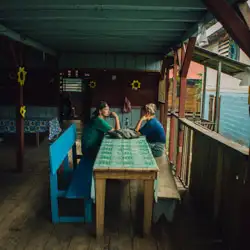
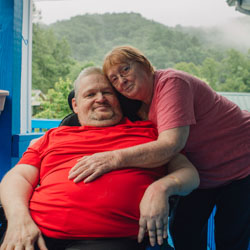
Hear from recent EM mission
trip team leaders!
Hear from recent EM mission trip team leaders!

Carline D. served in Savannah, Georgia
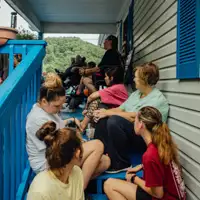
Nikki K. served in Pikeville, Kentucky
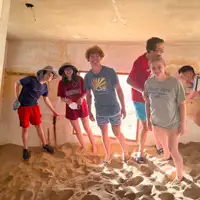
Christopher G. served in Rincon, Puerto Rico
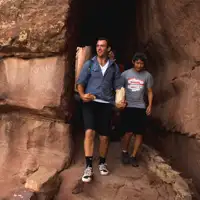
Jeremy M. served among the Navajo Nation in Arizona

Jennifer S. served in Rincon, Puerto Rico
What’s the best trip for your group? Answer 5 multiple choice questions and get instant mission trip recommendations!
What’s the best trip for your group?
Answer 5 multiple choice questions, and get instant mission trip recommendations!
Make your Mission Trip a reality!

1
Fill out a Group Interest Form
Only takes a minute! Simply choose the community and trip dates you’re most interested in—no commitment necessary.
2
We’ll personally follow up with you this week
Answering your questions and walking you through the process of finding the best trip, registering your group, and preparing to serve together.
3
You and your team serve on a cross-cultural mission trip!
Organized and led by EM field staff or local partners, your trip will bring encouragement and light to people in difficult circumstances, as you learn what it means to care for all people, whoever and wherever you are.
Read our Mission Trip FAQ and Registration Policy. If you have additional questions or don't see the dates you're looking for, fill out an interest form for the trip closest to what you're hoping for and let us know the needs of your group.
Don't let fundraising slow you down!
Download the free EM Fundraising Guide for all our best tips and ideas for making fundraising for your next trip fun and easy.
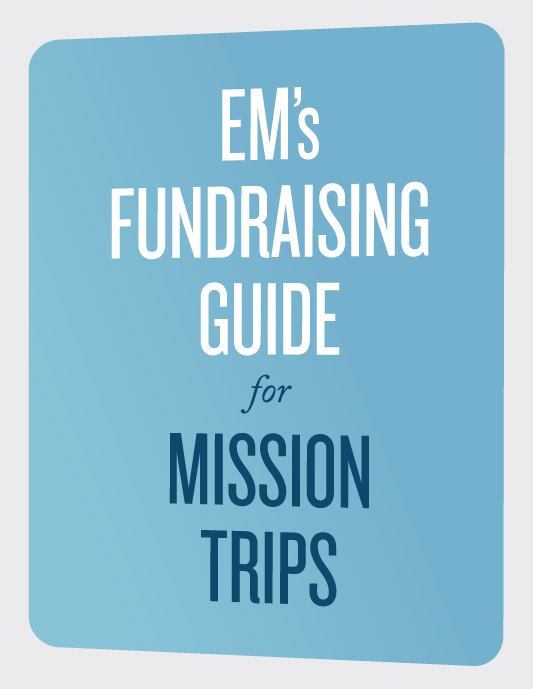

Don't let fundraising slow you down!
Download our free Fundraising Guide for all our best tips and ideas for making fundraising for your next trip fun and easy.
Site developed and hosted by Skycog, Inc.

